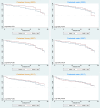Do various types of prelacteal feeding (PLF) have different associations with breastfeeding duration in Indonesia? A cross-sectional study using Indonesia Demographic and Health Survey datasets
- PMID: 38857945
- PMCID: PMC11168184
- DOI: 10.1136/bmjgh-2023-014223
Do various types of prelacteal feeding (PLF) have different associations with breastfeeding duration in Indonesia? A cross-sectional study using Indonesia Demographic and Health Survey datasets
Abstract
Introduction: Prelacteal feeding (PLF) is anything other than breastmilk given to newborns in the first few days of birth and/or before breastfeeding is established. PLF comes in many forms and is known as a challenge to optimal breastfeeding. Interestingly, both breastfeeding and PLF are common in Indonesia. This study investigated the association between PLF (any PLF, formula, honey, water and other milk) and breastfeeding duration.
Methods: This study used Indonesia Demographic and Health Surveys data from 2002, 2007 and 2017. Sample sizes were 5558 (2007), 6268 (2007) and 6227 (2017) mothers whose last child was aged 0-23 months. We used Cox regression survival analysis to assess the association between PLF and breastfeeding duration, estimating hazard ratios (HR) for stopping earlier.
Results: Overall PLF was prevalent (59%, 67% and 45% in 2002, 2007 and 2017, respectively), with formula being the most common (38%, 50% and 25%). No association between any PLF and breastfeeding duration in 2002 (HR 0.90 (95% CI 0.70 to 1.16)), but in 2007 and 2017, mothers who gave any PLF were more likely to stop breastfeeding earlier than those who did not (HR 1.33 (95% CI 1.11 to 1.61) and 1.47 (95% CI 1.28 to 1.69), respectively), especially in the first 6 months (HR 2.13 (95% CI 1.55 to 2.92) and 2.07 (95% CI 1.74 to 2.47), respectively). This association was more consistent for milk-based PLF. For example, HR in 2017 was 2.13 (95% CI 1.78 to 2.53) for prelacteal formula and 1.73 (95% CI 1.39 to 2.15) for other milk. The associations were inconsistent for the other PLF types. Prelacteal water showed no association while prelacteal honey showed some association with a longer breastfeeding duration in 2002 and 2007.
Conclusion: The impact of PLF on breastfeeding duration varied by type. While this study supports current recommendations to avoid PLF unless medically indicated, the potential consequences of different PLF types on breastfeeding outcomes should be clearly communicated to healthcare providers and mothers. Further research should explore the reasons for the high PLF prevalence in this setting.
Keywords: Child health; Cross-sectional survey; Epidemiology; Maternal health; Public Health.
© Author(s) (or their employer(s)) 2024. Re-use permitted under CC BY. Published by BMJ.
Conflict of interest statement
Competing interests: None declared.
Figures
Similar articles
-
Prevalence of prelacteal feeding and associated risk factors in Indonesia: Evidence from the 2017 Indonesia Demographic Health Survey.PLoS One. 2020 Dec 3;15(12):e0243097. doi: 10.1371/journal.pone.0243097. eCollection 2020. PLoS One. 2020. PMID: 33270720 Free PMC article.
-
Determinants of prelacteal feeding practice in Uganda; a population based cross-sectional study using Uganda demographic and health survey data.Malawi Med J. 2021 Dec;33(4):269-275. doi: 10.4314/mmj.v33i4.7. Malawi Med J. 2021. PMID: 35291386 Free PMC article.
-
Prelacteal feeding and its relationship with exclusive breastfeeding and formula consumption among infants in low- and middle-income countries.J Glob Health. 2022 Dec 23;12:04104. doi: 10.7189/jogh.12.04104. J Glob Health. 2022. PMID: 36560875 Free PMC article.
-
Initiating breastfeeding: a world survey of the timing of postpartum breastfeeding.Int J Nurs Stud. 1990;27(3):303-13. doi: 10.1016/0020-7489(90)90045-k. Int J Nurs Stud. 1990. PMID: 2199383 Review.
-
Nutrition, growth, and allergic diseases among very preterm infants after hospital discharge.Dan Med J. 2013 Feb;60(2):B4588. Dan Med J. 2013. PMID: 23461996 Review.
Cited by
-
Factors Associated With Prelacteal Feeding of Commercial Milk Formula: An Analysis of Cohort Data From the BADUTA Study in Indonesia.Matern Child Nutr. 2025 Apr;21(2):e13790. doi: 10.1111/mcn.13790. Epub 2025 Jan 3. Matern Child Nutr. 2025. PMID: 39749803 Free PMC article. Clinical Trial.
-
Prevalence and risk factors of acute respiratory infection and diarrhea among children under 5 years old in low-middle wealth household, Indonesia.Infect Dis Poverty. 2025 Feb 27;14(1):13. doi: 10.1186/s40249-025-01286-9. Infect Dis Poverty. 2025. PMID: 40016855 Free PMC article.
References
-
- National Population and Family Planning Board (BKKBN), Statistics Indonesia (BPS), Ministry of Health (Kemenkes), ICF . Indonesia Demographic and Health Survey 2017. Jakarta, Indonesia, 2018.
-
- WHO . Infant and young child feeding counselling: an integrated course, director’s guide. 2021. Available: http://apps.who.int/iris/handle/10665/343572
-
- WHO . Infant and young child feeding: model chapter for textbooks for medical students and Allied health professionals. 2009. Available: https://apps.who.int/iris/handle/10665/44117 - PubMed
-
- WHO/UNICEF . Protecting, Promoting and Supporting Breastfeeding in Facilities Providing Maternity and Newbornservices: Implementing the Revised Baby-Friendly Hospital Initiative 2018. Geneva, 2018.
MeSH terms
Grants and funding
LinkOut - more resources
Full Text Sources
Medical



